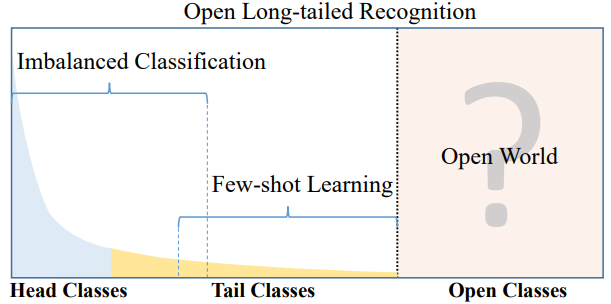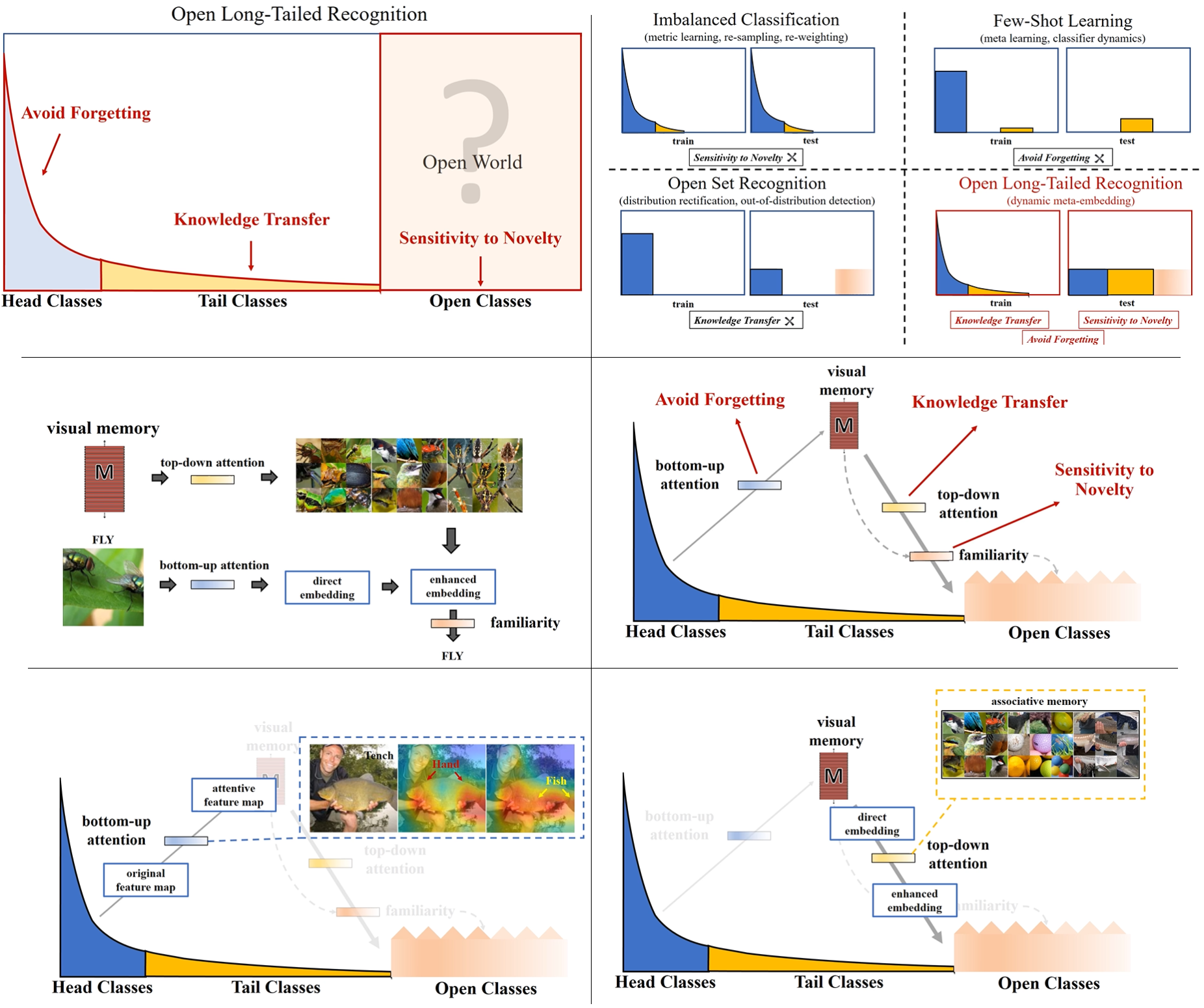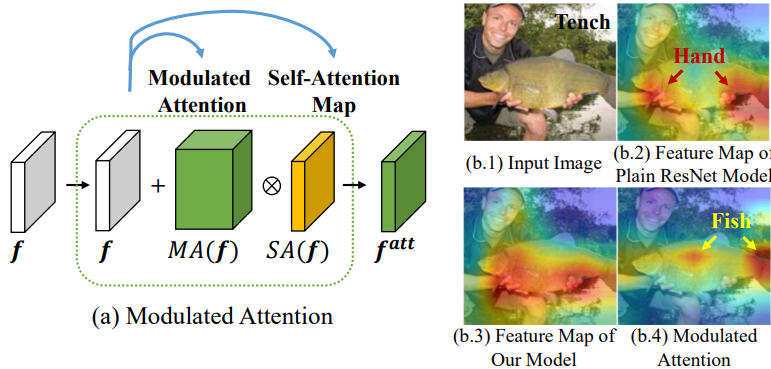【ClassBlance】Large-Scale Long-Tailed Recognition in an Open World = OLTR w/ advice
- 논문 : Large-Scale Long-Tailed Recognition in an Open World - y2019-c103
- 분류 : Unsupervised Domain Adaptation
- 저자 : Ziwei Liu1,2∗ Zhongqi Miao2∗ Xiaohang Zhan1
- 읽는 배경 : (citation step1) Open Componunt Domain Adaptation에서 Memory 개념이 이해가 안되서 읽는 논문.
- 읽으면서 생각할 포인트 : 논문이 어떤 흐름으로 쓰여졌는지 파악하자. 내가 나중에 쓸 수 있도록.
- 동영상 자료
- 질문
- centroids메모리 M을 어떻게 학습시키는지는 아직 모르겠다. 이것은 코드를 통해서 공부하면 될듯.
OLTR/models/MetaEmbeddingClassifier.py 파일에 forward의 input으로 centroids가 들어가는 것을 확인할 수 있다.
- centroids메모리 M을 어떻게 학습시키는지는 아직 모르겠다. 이것은 코드를 통해서 공부하면 될듯.
- 선배님 조언
- 외국에서 사는게 그리 좋은게 아니다. 우리나라 라는 것이 얼마나 큰 축복인지 모른다. 기회가 있다면 나가서 일하고 나중에 다시 돌아오면 된는거다. 우리나라에 대해서 감사함을 가지고 살아가도록 해야겠다.
- 특히나 외국에서 오래 살고 오셨기 때문에, 저 진심으로 해주시는 조언이었다. 그냥 큰 환상을 가지고 거기서 살고 싶다 라는 생각을 해봤자 환상은 깨지기 마련이고, 우리나라 안에서, 우리나라가 주는 편안함과 포근함에 감사하며 살아가는게 얼마나 큰 축복인지 알면 좋겠다. 모비스와 다른 외국 기업과의 비교를 생각하며 감사할 줄 몰랐다. 하지만 감사하자. 모비스에 가서도 정말 열심히 최선을 다해, 최고가 되기 위해 공부하자. 그렇게 해야 정말 네이버든 클로버든 갈 수 있다. 그게 내가 정말 가야할 길이다. 그러다가 기회가 되어 외국 기업이 나를 부른다면, 다녀오면 된다. 그리고 또 한국이 그리워지면 다시 돌아오면 되는거다. 나의 미래를 좀 더 구체적으로 만들어 주신 선배님께 감사합니다.
- 학교에서 너무 많은 것을 배우려고 하지 마라. 수업은 그냥 쉬운게 짱. 하고 싶은 연구하고 하고 싶은 공부하는게 최고다. 그리고 동기와 친구와 같이 수업 듣는 것을 더 추천한다.
느낀점
- Instruction이 개같은 논문은..
- abstract 빠르게 읽고, Introduction 대충 읽어 넘겨야 겠다. 뭔소리하는지 도저히!!!!!! 모르겠다.
- 지내들이 한 과정들을 요약을 해놨는데.. 나는 정확히 알지도 못하는데 요약본을 읽으려니까 더 모르겠다.
- 따라서 그냥 abstract읽고 introduction 대충 모르는거 걍 넘어가서 읽고.
- relative work의 새로운 개념만 빠르게 훑고, 바로 Ours Model에 대한 내용들을 먼저 깊게 읽자. 그림과 함께 이해하려고 노력하면서.
- 그리고! Introduce을 다시 찾아가(👋) 읽으며, 내가 공부했던 내용들의 요약본을 읽자
- 아무리 Abstract, Instruction, Relative work를 읽어도, 이해가 되는 양도 정말 조금이고 머리에 남는 양도 얼마 되지 않는다. 지금도 위 2개에서 핵심이 뭐였냐고 물으면, 대답 못하겠다.
- 현재의 머신러닝 논문들이 다 그런것 같다. 그냥 대충 신경망에 때려 넣으니까 잘된다.
- 하지만 그 이유는 직관적일 뿐이다. 따라서 대충 이렇다저렇다 삐까뻔쩍한 말만 엄청 넣어둔다. 이러니 이해가 안되는게 너무나 당연하다.
- 이런 점을 고려해서, 좌절하지 않고 논문을 읽는 것도 매우 중요한 것 같다. (👋)여기 아직 안읽었다고??? 걱정하지 마라. 핵심 Model 설명 부분 읽고 오면 더 이해 잘되고 머리에 남는게 많을거다. 화이팅.
- 확실히 Model에 더 집중하니까, 훨씬 좋은 것 같다. 코드까지 확인해서 공부하면 금상첨화이다. 이거 이전에 읽은 논문들은, 그 논문만의 방법론에는 집중하지 못했는데, 나중에 필요하면 꼭! 다시 읽어서 여기 처럼 자세히 정리해 두어야 겠다.
- 이 논문의 핵심은 이미 파악했다. 👋 읽기 싫다. 안 읽고 정리 안했으니, 나중에 필요하면 참고하자. 명심하자. 읽을 논문은 많다. 모든 논문을 다 정확하게 읽는게 중요한게 아니다.
0. Abstract
- the present & challenges
- Real world data often have a long-tailed and open-ended distribution. 즉 아래의 그래프의 x축은 class종류를 데이터가 많은 순으로 정렬한 것이고, y축은 해당 클래스를 가지는 데이터 수. 라고 할 수 있다. Open Class는 우리가 굳이 Annotate 하지 않는 클래스이다.

- Ours - 아래 내용 요약
1. Introduction
- the past
- 대부분의 기법들은 Head Class 인식에 집중하지만,
최근 Tail class 문제를 해결하기 위한 방법이 존재한다. (=Few-shot Learning)for the small data of tail classes [52, 18]
- 대부분의 기법들은 Head Class 인식에 집중하지만,
- Ours
우리의 과제(with one integrated algorithm)
1) imbalanced classification
2) few-shot learning
3) open-set recognition
즉. tail recognition robustness and open-set sensitivity:Open Long-Tailed Recognition(OLTR) 이 해결해야하는 문제
1) how to share visual knowledge(=concept) between head and tail classes (For robustness)
2) how to reduce confusion between tail and open classes (For sensitivity)해결방법
2번째 페이지 We develop an OLTR 문단부터 너무 이해가 어렵다. 따라서 일단 패스하고 다시 오자. 요약본이니, 구체적으로 공부하고 나면 이해하기 쉬울 거다. 👋
# 이전에 정리해 놓은 자료. 나중에 와서 다시 참조. 1 mapping(=dynamic meta-embedding) an image to a feature space = **a direct feature** computed(embeded) from the input image from the training data 2) visual concepts(=visual memory feature) 이 서로서로 연관된다.(associate with) = A visual memory holds **discriminative centroids** 3) A summary of **memory activations** from the direct feature 그리고 combine into a meta-embedding that is enriched particularly for the tail class.
.
# 2. Related Works

Imbalanced Classification
- Classical methods - under-sampling head classes, over-sampling tail classes, and data instance re-weighting.
- Some recent methods - metric learning, hard negative mining, and meta learning.
- Ours
- combines the strengths of both metric learning[24, 37] and meta learning[17, 59]
- Our dynamic meta-embedding~~~ 👋
Few-Shot Learning
- 초기의 방법들 they often suffer a moderate performance drop for head classes.
- 새로운 시도 : The few-shot learning without forgetting, incremental few-shot learning.
- 하지만 : 위의 모든 방법들은, the training set are balanced.
- In comparison, ours~~~ 👋
Open-Set(new data set) Recognition
- OpenMax [3] : calibrating the output logits
- OLTR approach incorporates~~ 👋
3. Our OLTR Model

- 우리 모델의 핵심은 Modulated Attention 그리고 Dynamic meta-embedding 이다.
- dynamic Embedding : visual concepts(transfers knowledge) between head and tail
- modulated Attention : discriminates(구분한다) between head and tail
- reachability : separates between tail and open
- Our OLTR Model
- We propose to map(mapping하기) an image to a feature space /such that visual concepts can easily relate to each other /based on a learned metric /that respects the closed-world classification /while acknowledging the novelty of the open world.
3-1. Dynamic Meta-Embedding
combines a direct image feature and an associated memory feature (with the feature norm indicating the familiarity to known classes)
- CNN feature 추출기 가장 마지막 뒷 단이 V_direct(linear vector=direct feature)이다. (classification을 하기 직전)
- tail classes(data양이 별로 없는 class의 데이터)에는 사실 V_direct이 충분한 feature들이 추출되어 나오기 어렵다. 그래서 tail data와 같은 경우, V_memory(memory feature) 와 융합되어 enrich(좀더 sementic한 정보로 만들기) 된다. 이 V_memory에는 visual concepts from training classes라는게 들어가 있다.
Learning Visual Memory (M)
- [23] 이 논문의 class structure analysis and adopt discriminative centroids 내용을 따랐다.
 여기서 K는 class의 갯수이다.
여기서 K는 class의 갯수이다.- M은 V_direct에 의해서 학습이 된다. centroids 정보가 계속적으로 Update된다고 한다. 여기서 centroids정보는 아래의 삼각형 위치이다. 아래의 작은 동그라미가 V_direct 정보이고, 그것의 중심이 centroids가 된다.
- 이 centroids는 inter-class에 대해서 거리가 가장 가깝게, intra-class에 대해서는 거리가 최대한 멀게 설정한다.

- centroids를 어떻게 계산하면 되는지는 코드를 좀만 더 디져보면 나올 듯하다. 아래 python코드의 centroids가 핵심이다. centroids는 model의 forward 매개변수로 들어온다.
Memory Feature (V_memory)
O : V_direct와 i번째 클래스간의 상관계수(coefficients hallucinated(상관관계라고 환각이 느껴지는 단순한 Fully Conected Layer….))를 의미한다.
V_memory는 아래의 코드처럼 M과 O를 torch.matmul해서 만들어 낸다.

# set up visual memory . [M 만들기] x_expand = x.clone().unsqueeze(1).expand(-1, self.num_classes, -1) centroids_expand = centroids.clone().unsqueeze(0).expand(batch_size, -1, -1) keys_memory = centroids.clone() # computing reachability dist_cur = torch.norm(x_expand - centroids_expand, 2, 2) values_nn, labels_nn = torch.sort(dist_cur, 1) scale = 10.0 reachability = (scale / values_nn[:, 0]).unsqueeze(1).expand(-1, feat_size) # computing memory feature by querying and associating visual memory # self.fc_hallucinator = nn.Linear(feat_dim, num_classes) values_memory = self.fc_hallucinator(x.clone()) values_memory = values_memory.softmax(dim=1) memory_feature = torch.matmul(values_memory, keys_memory)
V_meta

- V_meta이 정보가 마지막 classifier에 들어가게 된다.

- 왼쪽 이미지 처럼, 그냥 V_direct를 사용하면, inter-class간의 거리가 멀리 떨어지는 경우도 생긴다.
- 오른쪽 그림은, V_meta를 확인한 것인데, inter-class간의 거리가 더 가까워진 것을 확인할 수 있다.
Reachability (γ)
- closed-world class에 open-world class를 적용하는데 도움을 준다.
- 공식은 이와 같고,

- 이것이 의미하는 바는, class 중에서 어떤 class의 centroids와 가장 가까운지 Open-world data의 V_direct와 비교를 하는 것이다. 가장 가까운 class에 대해서(γ 작음) V_meta에 큰 값을(1/γ큼) 곱해 주게 된다.
- 이것은, encoding open classes를 사용하는데에 더 많은 도움을 준다.
e (concep selector)
- head-data의 V_direct는 이미 충분한 정보를 담고 있다. tail-data의 V_direct는 상대적으로 less sementic한 정보를 담고 있다.
- 따라서 어떤 데이터이냐에 따라서 V_memory를 사용해야하는 정보가 모두 다르다. 이런 관점에서 e (nn.Linear(feat_dim, feat_dim)) 레이어를 하나 추가해준다.
- 따라서 e는 다음과 같이 표현할 수 있다.

dynamic meta-embedding **facilitates feature sharing** between head and tail classes
3-2. Modulated Attention
- Modulated attention : encourages different classes to use different contexts(attentions), which helps maintain the discrimination between head and tail classes.
- V_direct를 head와 tail class 사이, 그리고 intra-class사이의 차이를 더 크게 만들어 주는 모듈이다. 위의 이미지에서 f가 f^(att)가 되므로써, 좀 더 자신의 class에 sementic한 feature를 담게 된다. 이 attention모듈을 사용해서 f에 spatial and different contexts를 추가로 담게 된다.
- 아래의 Attention 개념은 논문이나, 코드를 통해 확인
- SA : self-correlation, contextual information [56]
- MA : conditional spatial attention [54]
 여기서 f는 CNN을 통과한 classifier들어가기 바로 전.
여기서 f는 CNN을 통과한 classifier들어가기 바로 전.- 이 개념은 다른 어떤 CNN모듈에 추가해더라도 좋은 성능을 낼 수 있는 flexible한 모듈이라고 한다.
3.3 Learning
- cosine classifier [39, 15]를 사용한다. 해당 논문 2개는 few-shot 논문이다.
- 이 방법은 아래의 방법을 사용하는 방법이다. V_meta와 classifier의 weight까지 normalize한다.

- 이러한 normalize에 의해서, vectors of small magnitude는 더 0에 가까워지고, vectors of big magnitude는 더 1에 가까워 진다. the reachability γ 와 융합되어 시너지 효과를 낸다고 한다.
3.4 Loss function

- cross-entropy classification loss, large-margin loss
- 내 생각. 위 식의 v^meta는 classification이 된 결과를 말하는 것일 것이다. vector_meta가 아니라.
- 오른쪽 loss항을 통해서, the centroids {ci} K i=1 를 학습 시킨다.
- 자세한 loss 함수는 부록 참조
4. Experiments
- Datasets
- Image-Net2012를 사용해서 head와 tail을 구성시킨다. 115.8k장의 이미지. 1000개의 카테고리. 1개의 카테고리에 최대 이미지 1280개, 최소 이미지 5개로 구성한다.
- Openset은 Image-Net2010을 사용하였다.
- Network Architecture - ResNet 사용
- Evaluation Metrics
- the closed-set (test set contains no unknown classes)
- the open-set (test set contains unknown classes)
- Train을 얼마나 반복해서 시켰는지에 따라서, many-shot classes / medium-shot classes / few-shot classes를 기준으로 accuracy를 비교해 보았다.
- For the open-set setting, the F-measure is also reported for a balanced treatment of precision and recall following [3]. (혹시 내가 Open-set에 대한 accuracy 평가를 어떻게 하는지 궁금해 진다면 이 measure에 대해서 공부해봐도 좋을 듯 하다.)
- Ablation Study / Result Comparisons / Benchmarking results



